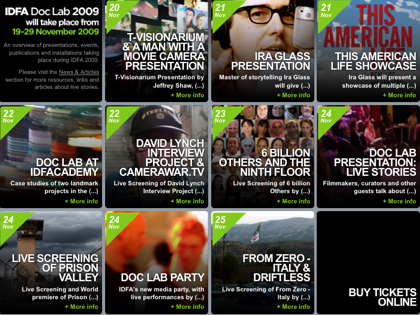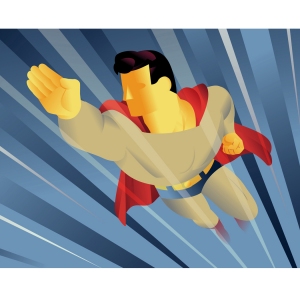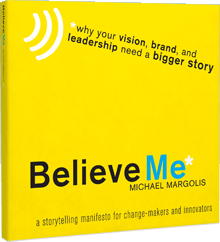Ben Macintyre’s Times of London article from two weeks ago, The internet is killing storytelling continues to generate huge buzz on Twitter, and I expected to vehemently disagree with it. But I surprised myself by acknowledging that Macintyre has a few good points.
First, I like the staccato spew of his opening salvo:
Click, tweet, e-mail, twitter, skim, browse, scan, blog, text: the jargon of the digital age describes how we now read, reflecting the way that the very act of reading, and the nature of literacy itself, is changing.

I also admit that the Internet has diminished my attention span. I find it harder and harder to summon the patience to read longer newspaper and magazine stories these days — like Nicholas Carr’s experience that Macintryre describes:
[Atlantic Monthly essayist Nicholas Carr] admitted that he can no longer immerse himself in substantial books and longer articles in the way he once did. “What the net seems to be doing is chipping away at my capacity for concentration and contemplation,” he wrote. “My mind now expects to take in information the way the net distributes it: in a swift-moving stream of particles.”
Thus, I can’t completely disagree with Macintyre’s claim: “If the culprit is obvious, so is the primary victim of this radically reduced attention span: the narrative, the long-form story, the tale. … Very few stories of more than 1,000 words achieve viral status on the internet.”
This last statement is probably true, though Macintyre offers no evidence. (Stephanie West Allen cited this blog entry in which David DiSalvo points out the lack of any citations that support Macintyre’s assertions.)
But here’s where we start to part ways. Macintryre writes: “The blog is a soap box, not a story. Facebook is a place for tell-tales perhaps, but not for telling tales.” Sure, that’s true of some blogs — but many others are wonderful venues for storytelling, providing a storied outlet for both writers and readers that didn’t exist 15 years ago. And while storytelling on Facebook may be flawed, millions more people are telling and reading stories than did before the age of social media.
I disagree with Macintyre’s assertion that Internet storytelling is not nourishing us. The vast variety of ways the Internet has opened up for people to tell stories has led not to an anorexic culture but one confronting a Thanksgiving feast of story possibilities:
The internet is there for snacking, grazing and tasting, not for the full, six-course feast that is nourishing narrative. The consequence is an anorexic form of culture.
I certainly agree with these assertions by Macintyre — except for the “paradoxically” part. Since we do hunger in unprecedented ways for stories, it is not at all paradoxical that the Internet has provided vast, unprecedented, and varied tools and venues for storytelling:
Paradoxically, there has never been a greater hunger for narrative, for stories that give shape and meaning to experience. .. Our fascination with other people’s stories is as great, if not greater, than any time in history.
In a blog entry, Dan Conover, Joel Achenbach and Deborah Potter on storytelling,
responding to a different piece written before Macintyre’s piece ever appeared, Deborah Potter wrote:
… is Twitter a threat to storytelling? Of course not. And not just for the obvious reason that Twitter is an entirely different medium from long-form narrative. It’s never going to replace good writing. Checking a Twitter stream is an entirely different experience from curling up with a good book, and most serious readers — even those who are also avid tweeters — wouldn’t trade one for the other. But here the real reason Twitter isn’t a threat to storytelling: Twitter can make writing better.
So, two more points to counter Macintyre’s argument: There’s still plenty of room for long-form narrative in people’s lives, and sometimes less is more. Where is it written that stories must be long to be good?
Jean Marie Tenlen responded to Macintyre’s essay with a blog entry carrying examples “to illuminate the multiple layers of narrative that the Internet enables.”
Macintyre’s piece also sparked discussion on Golden Fleece’s Working Stories discussion list. A few excerpts:
I don’t agree. That’s like saying sex is killing love.
— Seth Kahan, president, Performance Development Group, Inc.
A similar perspective as this article was posited by a well known neuroscientist (who I remember had a grand title but I don’t remember her name) from the UK who said that gaming was killing social capabilities. It was a TV report and I laughed to myself when they cut to four young guys in an in-depth conversation about how to best make progress in one of the latest video games. Seemed like there was plenty of socialising happen and the game was the trigger.
— Shawn Callahan, Anecdote
… my teenage kids are just as likely to read Harry Potter, Lord of the Rings, etc as they are to spend time on Facebook and IM’ing. In fact, they spend hours IM’ing, which seems to me to be the modern equivalent of hours on the phone. They spend just as much time gossiping (telling each other stories) as I did as a teenager. They watch movies, and as I said, they also read books. Long books with intricate plots that carry through the series. They don’t like reading most of the texts they are given to read for school. So what exactly is different? … WIth email, I write more than I did before email. I send friends interesting stuff about our travels, before it was what would fit on a postcard. So technology has helped me write more stories, well, personal stories. If we are talking about literature, well no, technology hasn’t added to me reading anymore than I did before the internet came along. But then it hasn’t reduced it either. I read when I am interested, I stop reading when I lose interest. I don’t think my level of interest, or attention span has changed as a result.
— Melanie White
What forms and venues for storytelling — as well as levels of storytelling participation — were unimaginable before the Internet?





